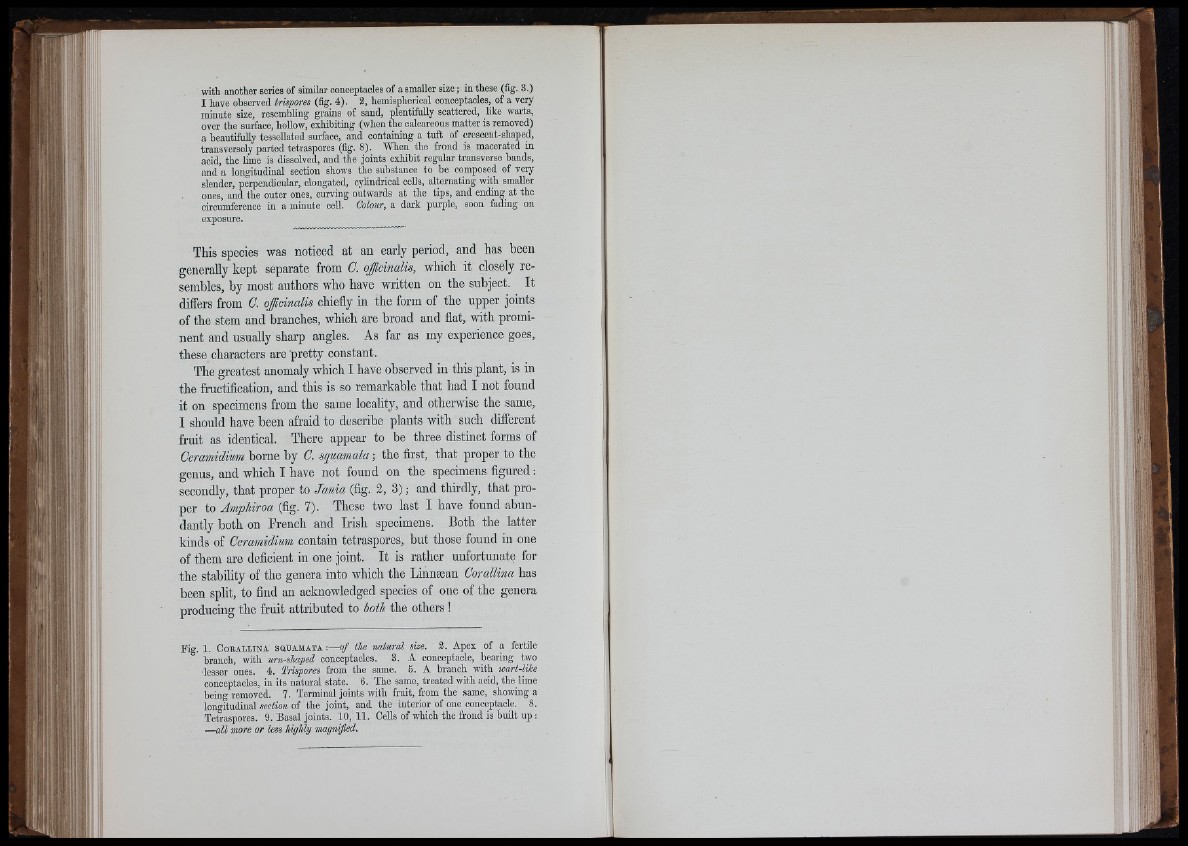
with another series of similar conceptacles of a smaller size ; in these (fig. 3.)
I have observed trispores (fig. 4). 2, hemispherical conceptacles, of a very
minute size, resembling grains of sand, plentifully scattered, like warts,
over the siu'face, hollow, exhibiting (when the calcareous matter is removed)
a beautifully tessellated surface, and containing a tuft of crescent-shaped,
transversely parted tetraspores (fig. 8). When the frond is macerated in
acid, the lime is dissolved, and the joints exhibit regular transverse bands,
and a longitudinal section shows the substance to be composed of very
slender, perpendicular, elongated, cylindrical cells, alternating with smaller
ones, and the outer ones, curving outwards at the tips, and ending at the
circumference in a minute cell. Colour, a dark purple, soon fading on
exposure.
This species was noticed at an early period, and has been
generally kept separate from C. officinalis, which it closely resembles,
by most authors who have written on the subject. It
differs from C. officinalis chiefiy in the form of the upper joints
of the stem and branches, which are broad and flat, witb prominent
and usually sharp angles. As far as my experience goes,
these characters are pretty constant.
The greatest anomaly which I have observed in this plant, is in
the fructification, and this is so remarkable that had I not found
it on specimens from the same locality, and otherwise the same,
I should have been afraid to describe plants with such different
fruit as identical. There appear to be three distinct forms of
Ceramidium borne by C. squamata ; the first, that proper to the
genus, and which I have not found on the specimens figured ;
secondly, that proper to Jania (fig. 2, 3) ; and thirdly, that proper
to AmpUroa (fig. 7). These two last I have found abundantly
both on French and Irish specimens. Both the latter
kinds of Ceramidium contain tetraspores, but those found in one
of them are deficient in one joint. It is rather unfortunate for
the stability of the genera into which the Linnæan Corallina has
been split, to find an acknowledged species of one of the genera
producing the fruit attributed to hoth the others !
Fig. 1. Coeallina solamata ;—of the natural size. 2. Apex of a fertile
branch, with urn-shaped conceptacles. 3. A coneeptacle, bearing two
lesser ones. 4. Trispores from the same. 5. A branch with wart-like
conceptacles, in its natui-al state. 6. The same, treated with acid, the lime
being removed. 7. Terminal joints with fruit, from the same, showing a
longitudinal section of the joint, and the interior of one coneeptacle. 8.
Tetraspores. 9. Basal joints. 10, 11. Cells of which the frond is built up :
— all more or U ’ ' ”